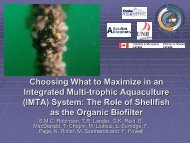Integrated multi-trophic aquaculture (IMTA) in marine temperate waters
Integrated multi-trophic aquaculture (IMTA) in marine temperate waters
Integrated multi-trophic aquaculture (IMTA) in marine temperate waters
Create successful ePaper yourself
Turn your PDF publications into a flip-book with our unique Google optimized e-Paper software.
12<br />
<strong>Integrated</strong> mariculture – A global review<br />
issues of susta<strong>in</strong>ability because of low prices due to oversupply, and the possibility of<br />
catas<strong>trophic</strong> destruction of one’s only crop (diseases, damag<strong>in</strong>g weather conditions).<br />
Consequently, diversification of the <strong>aquaculture</strong> <strong>in</strong>dustry (especially at the local and<br />
regional levels) is imperative to reduce the economic risks and ma<strong>in</strong>ta<strong>in</strong> its susta<strong>in</strong>ability<br />
and competitiveness.<br />
The traditional view of diversification often means produc<strong>in</strong>g another product along<br />
the same l<strong>in</strong>es of the first, that would fit <strong>in</strong>to the exist<strong>in</strong>g production and market<strong>in</strong>g<br />
systems. In f<strong>in</strong>fish <strong>aquaculture</strong> <strong>in</strong> North America and Northern Europe, this has<br />
usually meant salmon, cod, haddock or halibut. However, from an ecological po<strong>in</strong>t<br />
of view, these are all “shades of the same colour”. No synergies are created; rather,<br />
these situations compound the impacts on the system. True ecological diversification<br />
of <strong>aquaculture</strong> means farm<strong>in</strong>g at more than one <strong>trophic</strong> level, i.e. switch<strong>in</strong>g from<br />
another species of f<strong>in</strong>fish to another group of organisms of lower <strong>trophic</strong> level (e.g.<br />
shellfish, seaweeds, ech<strong>in</strong>oderms, polychaetes, bacteria, etc.), more resembl<strong>in</strong>g a natural<br />
ecosystem. Stay<strong>in</strong>g at the same ecological <strong>trophic</strong> level will not address some of the<br />
environmental issues because the system will rema<strong>in</strong> unbalanced due to the non-stable<br />
distribution of energy and non-diversified resource needs and outcomes.<br />
Product diversification should also mean look<strong>in</strong>g at seafood from a different angle.<br />
Aquaculture products on the market today are very similar to those obta<strong>in</strong>ed from the<br />
traditional fishery resources, and are, thus, often <strong>in</strong> direct competition. While this may<br />
be part of the market forces at work, the opportunity exists to diversify from the fish<br />
filets, or mussels and oysters on a plate <strong>in</strong> a restaurant, to a large untapped array of<br />
bioactive compounds of mar<strong>in</strong>e orig<strong>in</strong> (e.g. pharmaceuticals, nutraceuticals, functional<br />
foods, cosmeceuticals, botanicals, pigments, agrichemicals and biostimulants, and<br />
<strong>in</strong>dustry-relevant molecules). Consequently, research and development on alternative<br />
species should no longer be considered as R&D on alternative f<strong>in</strong>fish species, but<br />
rather on alternative mar<strong>in</strong>e products. Moreover, diversification should be viewed as an<br />
<strong>in</strong>vestment portfolio, with short-term, long-term, high risk and low-risk components,<br />
and with long-term growth and stability as the ma<strong>in</strong> objectives.<br />
There is a paradoxical situation when look<strong>in</strong>g at current worldwide food production.<br />
In agriculture, 80 percent of the production is made up of plants and 20 percent<br />
of animal products (meat, milk, eggs, etc.), while <strong>in</strong> <strong>aquaculture</strong>, 80 percent of the<br />
production is animal biomass and 20 percent is plant biomass (Chop<strong>in</strong> and Re<strong>in</strong>ertsen,<br />
2003). Consider<strong>in</strong>g only mariculture, the worldwide production <strong>in</strong> 2004 was made<br />
up of 45.9 percent seaweeds, 43.0 percent molluscs, 8.9 percent f<strong>in</strong>fish, 1.8 percent<br />
crustaceans, and 0.4 percent of varied other animals (FAO, 2006a). Consequently, <strong>in</strong><br />
many parts of the world, <strong>aquaculture</strong> is not synonymous to f<strong>in</strong>fish <strong>aquaculture</strong>, as so<br />
many people <strong>in</strong> affluent western countries believe. Based on the need for balanc<strong>in</strong>g<br />
the cultured species functions with<strong>in</strong> the surround<strong>in</strong>g ecosystem functions, mar<strong>in</strong>e<br />
herbivores, carnivores and omnivores cannot be cultivated while neglect<strong>in</strong>g mar<strong>in</strong>e<br />
plants – as efficient biofilters, a crop on their own, or a food component for other<br />
organisms – if we are to make the “Blue Revolution” (sensu Costa-Pierce, 2002)<br />
“greener”. Several species of seaweeds cultivated under the right conditions, especially<br />
near sources of high levels of nitrogen as <strong>in</strong> proximity to f<strong>in</strong>fish farms, can be excellent<br />
sources of prote<strong>in</strong>s, important am<strong>in</strong>o acids and unsaturated oils. We need to be aware<br />
of the other food production systems <strong>in</strong> the rest of the world if we want to understand<br />
our present prevail<strong>in</strong>g system and correctly position it <strong>in</strong> perspective with other<br />
systems. Seaweeds and micro-algivores (e.g. filter feed<strong>in</strong>g shellfish and herbivorous<br />
fish) represent 59 percent of the world <strong>aquaculture</strong> production, followed by the<br />
production of 30 percent of omnivores and detritivores. In tonnage, the three lead<strong>in</strong>g<br />
<strong>aquaculture</strong>d species are the seaweed Lam<strong>in</strong>aria japonica, and two micro-algivores,<br />
the Pacific cupped oyster, Crassostrea gigas, and the silver carp, Hypophthalmichthys<br />
molitrix. Vocal public opposition to <strong>aquaculture</strong> has been generated by “high value”



